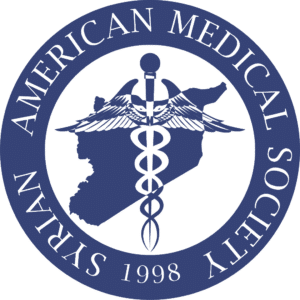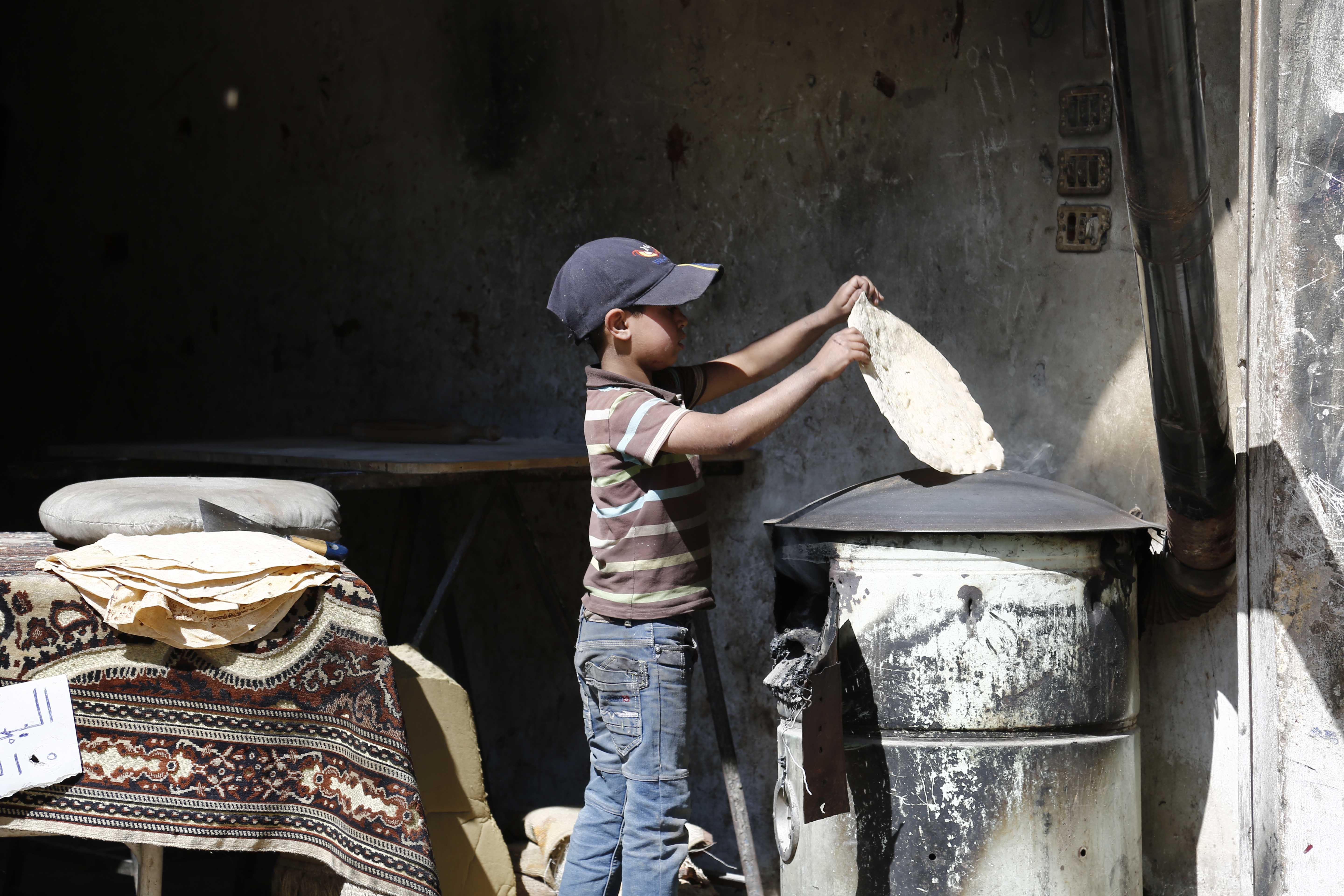“Hospitals are overwhelmed. Floors are overflowing with injured and blood. Those patients we discharged a couple of days ago are now back with more serious injuries…. The word “catastrophe” can’t describe what’s happening in East Ghouta. Why do we continue to let children die before our eyes? What have we done to deserve this?”
– SAMS doctor in East Ghouta.
The situation in East Ghouta is extremely dire. Currently, nearly 400,000 civilians are besieged in the area, including more than 130,000 children. Since 2012, civilians have faced frequent aerial attacks and shelling. Hospitals, marketplaces, schools, and other civilian areas continue to be targeted with impunity. In August 2013, 1,200 civilians were killed in a Sarin gas attack perpetrated by the Syrian government.
Since the beginning of the intensified aerial bombardment campaign over East Ghouta on February 18, 2018, more than 700 civilians have been killed and at least 5,500 injured. Aerial attacks continue despite a ceasefire that was unanimously voted agreed upon on February 24, 2018.
During this time period, at least 25 medical facilities have been targeted by attacks. We are heartbroken to share that four medical staff have been killed, including three of our own staff. Our hospitals have been overflowing with injured and wounded civilians.
Learn more about how SAMS is responding to the humanitarian crisis in East Ghouta.
On September 25, 2017, SAMS released their latest brief, Under Siege: The Plight of East Ghouta, highlighting the devastating impact of the four-year-long blockade on the health sector and underscores the pressing need to break the siege.
Read our report on the humanitarian situation inside East Ghouta.
Siege and the restriction of humanitarian assistance is a violation of international humanitarian law – it is, however, a daily reality for residents of East Ghouta. Since the start of the conflict, basic necessities have been severely restricted. By the end of 2012, electricity and water supplies were cut. The area has been under complete siege since 2013, leading to a severe shortage of medical supplies and basic supplies. The wounded, sick, and critically ill are not allowed to leave East Ghouta to receive the treatment they need. The delivery of goods and supplies has been severely restricted. Food prices have skyrocketed, fuel is scarce and essential medical supplies are few and far between.
The persistent aerial campaign against civilians in East Ghouta has also led to internal displacement. Internally Displaced Persons (IDPs) comprise over 33% of the population. According to UN OCHA’s June 2017 flash update, as of 22 March, more than 10,000 people have been displaced from Qaboun, Barzeh, and West Harasta to At Tall, while 17,000 others have been displaced within East Ghouta.
Syrian Children Disproportionately Affected by Siege
Children in East Ghouta pay a disproportionate price for the “starve or kneel” tactic that has been used throughout Syria since the beginning of the Syrian conflict. Currently, more than 13,000 children in East Ghouta are in dire need of medical care. The malnutrition ratio has skyrocketed from 2.1% to 11.9 % since the beginning of 2017, the highest seen throughout the Syrian conflict. The proportion of malnutrition in children under 24 months is higher than in other age groups.
SAMS-supported physicians have witnessed acute malnutrition cases amongst children, but they do not have access to supplies or micronutrients to treat these cases.
Residents of East Ghouta, and other besieged areas in Syria, are often forced to rely on diets of just a few ingredients such as barley and plant matter, which can lead to damaging nutritional deficiencies even when the items are available in sufficient quantity. Reports from field staff suggest that most residents of Eastern Ghouta lost between 5-50 kg (11-110 lbs) in 2014.
A recently conducted SMART nutrition survey by UNICEF cross-border partners in besieged East Ghouta, Rural Damascus, revealed a serious prevalence of stunting among children (30 percent or 1 in 3), revealing chronic deprivation of quality diet and poor infant and young child feeding practices.
Each month, East Ghouta sees close to 1,200 births. For expecting mothers, the situation has had serious health repercussions. In East Ghouta, the psychological effects of siege and aerial bombardment, coupled with the physical effects of malnutrition, have led to increased cases of premature births.
Each month, East Ghouta sees close to 1,200 births, and this number is on the rise.
Healthcare in East Ghouta
The health infrastructure in East Ghouta has been crippled by systematic aerial attacks and ongoing siege. Medical facilities face an extreme deficiency of supplies to manage trauma and non-trauma cases, including drugs like Paracetamol, Insulin, and essential antibiotics. There are currently 107 doctors in East Ghouta – one doctor for 3,600 patients.
Due to the incapacitated health infrastructure, contagious and preventable diseases such as measles and tuberculosis have appeared and spread rapidly. Medical staff have also seen an increase in tuberculosis, hemophilia, and tumors. Measles is treated with fever reducers, a healthy diet, and Vitamin A – however, none of these options are readily available for the many children whose lives are imperiled by the disease.
In East Ghouta, SAMS supports a nursery clinic that continues to receive cases on a daily basis. Functioning incubators are essential to keep infants alive. At the facility, there is a severe shortage of fuel to run incubators.
Doctors in East Ghouta do not have the resources to treat critical cases due to the siege, however, medical evacuations are rarely, if ever, allowed.
Currently, over 700 cases are in need of medical evacuation, including 65 under the age of 5, and 225 patients in need of surgery. 19 patients have died while waiting to be medically evacuated.
In August 2017 alone, four children died awaiting evacuation.
In August 2017, 9-year-old Sara passed away while negotiations for her evacuation were underway. She suffered from bilateral retinoblastoma, and she needed urgent chemotherapy, radiotherapy, and surgery. In the same month, 6-month-old Kenan passed away from leukemia while awaiting medical evacuation.
In September 2017, 5-year-old Osama lost his life due to acute herpetic encephalitis. Acyclovir, the antiviral medication needed to save his life, was available just kilometers away in Damascus.
In December 2017, 9-year-old Batoul passed away while waiting to be evacuated to access treatment for tuberculosis.
Also in December 2017, two infants, 6-month-old Katr and 8-month-old Emad, who were on the list of critically ill patients, died awaiting evacuation. They were on a list of 29 patients who had been granted medical evacuation to Damascus, however, the evacuation came too late. They both suffered from congenital heart disease.
We are appalled and heartbroken by these losses; parties standing in the way of treatment for children like Sara must be held accountable.
Dialysis Needs in East Ghouta
The Department of Hemodialysis in the Specialized Hospital in Damascus Countryside is the only department that performs hemodialysis sessions in besieged East Ghouta. This facility was established in 2013, using equipment unearthed from under the ruins of Douma’s decimated public hospital. The Hemodialysis facility first ran out of supplies in 2015. Because of the strict siege, the department struggled with a lack of equipment and medical supplies and was not able to provide sufficient dialysis sessions. This led to the death of 4 people in February and March 2017.
There are 45 patients in various stages of kidney failure, 17 of whom are receiving dialysis at a drastically reduced rate.
If there are no dialysis supplies in future convoys, these patients will succumb to their illnesses, despite the best efforts of East Ghouta’s tireless medical staff.
Humanitarian Aid & Access
Since the beginning of 2017, only 10 aid convoys have been permitted by the Syrian government to deliver aid to East Ghouta. Those aid convoys delivered less than one month’s needs of food, and much less in medical supplies. The United Nations said that only 26% of the requests to enter besieged areas are approved by the Syrian government.
Reports from two recent convoys recommended blanket food distribution in the whole of Ghouta for the duration of six months.
Commercial access is rarely permitted, and in the rare cases that it happens, high taxes are imposed, which can be as high as $5.00 per kilo of food. Medical items, fuel, and other NFI are not allowed to enter through this very limited and expensive access.
Where Do We Go From Here?
- SAMS calls for an end to the siege in East Ghouta and all besieged communities across Syria.
- Immediate entry of aid convoy with most needed supplies based on an impartial needs assessment, and a guarantee that government forces will not extract needed supplies.
- Convoys should include international monitors to assess and document the delivery of aid in order to ensure that the supplies are reaching the assigned areas.
- Evacuation of medical cases for most critical patients. There are currently 243 critical cases awaiting medical evacuation.
What Can YOU Do?
- Call, write to, or meet with your Member of Congress. Find your Member of Congress’ and Senators’ contact information here. Take a look at our East Ghouta Talking Points.
- Organize events, vigils, or rallies on behalf of the people of East Ghouta – show them that the world is standing with them.
- Write an Op-Ed to submit to your local media.
- Send a letter, or tweet at your local newspaper or broadcast news network, asking them to feature East Ghouta more prominently in their reporting, and on their websites.
- Reach out to SAMS with ideas and suggestions on how to amplify the needs of the people in East Ghouta.
- Donate to our “East Ghouta Fund” to support our medical staff who are committed to caring for the sick and wounded.
- Raise awareness of the current escalation and join the conversation on social media using the hashtag #SaveGhouta. Share personal stories of the women, children, and men who have been caught in the crisis. Please feel free to use some of the following tweets:
- Almost 400,000 people live in #EastGhouta, including more than 95,000 children under the age of 12. From Feb 19 – 25, over 500 have been killed, half of whom are women & children. #SaveGhouta
- 25 attacks on health care facilities in #EastGhouta in just a week. Over 3,000 injured. Healthcare in East Ghouta is being systematically attacked to prevent them from receiving life-saving care. #SaveGhouta
- Acute malnutrition cases amongst children is rampant in #EastGhouta. Children have no access to micronutrients and necessary treatments. #SaveGhouta
- In 2018 alone, there have been four chemical weapons attacks in East Ghouta, including one on February 25th. 197 chemical attacks in Syria since 2012. #SaveGhouta
- Three SAMS medical workers have perished in attacks on healthcare in East Ghouta this year. Medical workers are #NotATarget. Lift the siege in #EastGhouta, and ensure the protection of civilians and medical workers.
- Download and share the following graphics using the hashtag #SaveEastGhouta.
[ngg_images source=”galleries” container_ids=”37″ display_type=”photocrati-nextgen_basic_thumbnails” override_thumbnail_settings=”0″ thumbnail_width=”240″ thumbnail_height=”160″ thumbnail_crop=”1″ images_per_page=”20″ number_of_columns=”0″ ajax_pagination=”0″ show_all_in_lightbox=”0″ use_imagebrowser_effect=”0″ show_slideshow_link=”0″ slideshow_link_text=”[Show slideshow]” order_by=”sortorder” order_direction=”ASC” returns=”included” maximum_entity_count=”500″]Photos: Abdulmonam Eassa/Syrian American Medical Society


